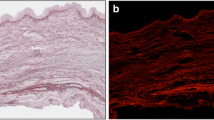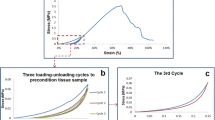Abstract
Introduction and hypothesis
Our aim is to characterize prolapsed and non-prolapsed vaginal tissue, and thus offer a better understanding of the genital prolapse physiopathology and an improvement of surgical treatments.
Methods
Vaginal tissue was collected in 30 patients with prolapse (POP) and ten fresh cadavers without prolapse (nPOP) with a favorable advice of Ethics Committee. Uniaxial tension tests were performed. Statistical comparisons of rigidity under moderate deformation and under large deformation have been performed
Results
POP is significantly stiffer than nPOP tissue, both on anterior and posterior walls. A significant difference between POP and nPOP tissues was highlighted when anterior or posterior vaginal walls were respectively compared.
Conclusions
These results might explain the higher rate of relapse when repair is autologous, using already defective and more rigid vaginal tissue. This study suggests that it might be interesting to adapt the characteristics of prosthetic implants to the vaginal face concerned by the prolapsus.
Similar content being viewed by others
References
Samuelsson E, Victor F, Tibblin G, Svardsudd K (1999) Signs of genital prolapse in a Swedish population of women 20 to 59 years of age and possible related factors. Am J Obstet Gynecol 180:299–305
Swift SE (2000) The distribution of pelvis organ support in a population of female subjects seen for routine gynecologic health care. Am J Obstet Gynecol 183:277–285
Shull BL (1999) Pelvic organ prolapse: anterior, superior and posterior vaginal segment defects. Am J Obstet Gynecol 181:6–11
Weber AM, Walters MD, Piedmonte MR, Ballard LA (2001) Anterior colporrhaphy: a randomized trial of three surgical techniques. Am J Obstet Gynecol 185:1299–1304, discussion 1304-6
Gauruder-Burmester A, Koutouzidou P, Rohne J, Gronewold M, Tunn R (2007) Follow-up after polypropylene mesh repair of anterior and posterior compartments in patients with recurrent prolapse. Int Urogynecol J Pelvic Floor Dysfunct 18:1059–1064
De Tayrac R, Devoldere G, Renaudie J, Villard P, Guilbaud O, Eglin G, French Ugytex Study Group (2007) Prolapse repair by vaginal route using a new protected low-weight polypropylene mesh: 1-year functional and anatomical outcome in a prospective multicentre study. Int Urogynecol J Pelvic Floor Dysfunct 18:251–256
Fatton B, Amblard J, Debodinance P, Cosson M, Jacquetin B (2007) Transvaginal repair of genital prolapse: preliminary results of a new tension-free vaginal mesh (Prolift technique)—a case series multicentric study. Int Urogynecol J Pelvic Floor Dysfunct 18:743–752
Cosson M, Boukerrou M, Lambaudie E, Lobry P, Crepin G, Ego A (2003) Biomechanics of stress distribution and resistance of biological tissues: why use prostheses for the treatment of genital prolapse? J Gynécol Obstét Biol Reprod 32:329–337
Goh JT (2003) Biomechanical and biochemical assessments for pelvic organ prolapse. Curr Opin Obstet Gynecol 15:391–394
Jackson SR, Avery NC, Tarlton JF, Eckford SD, Abrams P, Bailey AJ (1996) Changes in metabolism of collagen in genitourinary prolapse. Lancet 347:1658–1661
Baden W, Walker T, Lindsay H (1968) The vaginal profile. Tex Med J 64:56–58
Rubod C, Boukerrou M, Brieu M, Dubois P, Cosson M (2007) Biomechanical properties of vaginal tissue. Part 1: new experimental protocol. J Urol 178:320–325
Brown RP (1996) Physical testing of rubber, 3rd edn. Chapman & Hall, London, UK
Rubod C, Boukerrou M, Brieu M, Jean-Charles C, Dubois P, Cosson M (2008) Biomechanical properties of vaginal tissue: preliminary results. Int Urogynecol J Pelvic Floor Dysfunct 19:811–816
Diani J, Brieu M, Gillormini P (2006) Observation and modeling of the anisotropic visco-hyperelastic behavior of a rubberlike material. Int J Solids Struct 43–10:3044–3056
Diani J, Brieu M, Vacherand JM (2006) A damage directional constitutive model for Mullins effect with permanent set and induced anisotropy. Eur J Mech 25:483–496
Alexander H (1971) Tensile instability of intially spherical ballons. Int J Eng Sci 9:549–563
Rivlin RS (1948) Large elastic deformation of isotropic materials I. Fundamental concepts, II Some uniqueness theorems for pure homogeneous deformations. Phil Trans Roy Soc A240:459–490
Mooney M (1940) A theory of large elastic deformation. J Appl Phys 11:582–592
Ogden RW (1984) Non linear elastic deformations. Dover Publications Inc, New York
Ettema GJ, Goh JT, Forwood MR (1998) A new method to measure elastic properties of plastic-viscoelastic connective tissue. Med Eng Phys 20:308–314
Cosson M, Lambaudie E, Boukerrou M, Lobry P, Crépin G, Ego A (2004) A biomechanical study of the strength of vaginal tissues. Results on 16 post-menopausal patients presenting with genital prolapse. Eur J Obstet Gynecol Rprod Biol 112:201–205
Goh JT (2002) Biomechanical properties of prolapsed vaginal tissue in pre and postmenopausal women. Int Urogynecol J Pelvic Floor Dysfunct 13:76–79
Lei L, Song Y, Chen R (2007) Biomechanical properties of prolapsed vaginal tissue in pre- and postmenopausal women. Int Urogynecol J 18:603–607
Takano CC, Girão MJ, Sartori MG, Castro RA, Arruda RM, Simões MJ, Baracat EC, Rodrigues de Lima G (2002) Analysis of collagen in parametrium and vaginal apex of women with and without uterine prolapse. Int Urogynecol J Pelvic Floor Dysfunct 13:342–345
Norton P, Boyd C, Deak S (1992) Collagen synthesis in women with genital prolapse or stress urinary incontinence. Neurourol Urodyn 11:300
Acknowledgements
This study was granted an unconditional financial support from Ethicon.
Conflicts of interest
None.
Author information
Authors and Affiliations
Corresponding author
Rights and permissions
About this article
Cite this article
Jean-Charles, C., Rubod, C., Brieu, M. et al. Biomechanical properties of prolapsed or non-prolapsed vaginal tissue: impact on genital prolapse surgery. Int Urogynecol J 21, 1535–1538 (2010). https://doi.org/10.1007/s00192-010-1208-z
Received:
Accepted:
Published:
Issue Date:
DOI: https://doi.org/10.1007/s00192-010-1208-z




